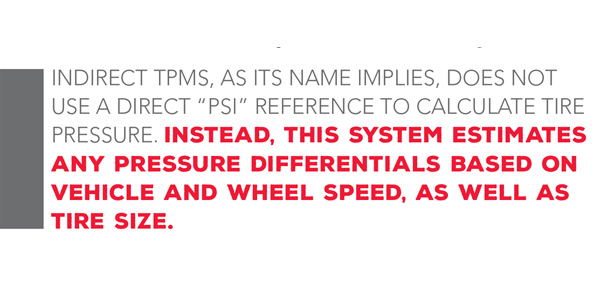
It’s been more than a decade since the federal government first mandated that new vehicles feature tire-pressure monitoring systems to warn drivers against underinflation. Direct TPMS sensors and their service kits are a common stocking item for parts stores, tire shops and even general repair shops nationwide, but while these sensors are now well-known and widely available, there is another system that provides tire-pressure monitoring without sensor service and replacement.
In the case of direct TPMS, radio frequency signals from each tire-mounted sensor are transmitted to a central receiver, where the individual air-pressure readings are compared to the manufacturer’s recommended inflation pressure. If the actual pressure in any tire drops below 75 percent of this recommended calibration, the warning light will illuminate. Some manufacturers also display the actual pressure of each tire in their driver information center (usually found in the gauge cluster) during startup.
Indirect TPMS, as its name implies, does not use a direct “PSI” reference to calculate tire pressure. Instead, this system estimates any pressure differentials based on vehicle and wheel speed, as well as tire size. Indirect TPMS piggybacks on the ABS and traction-control system, using the information from these sensors to determine if an individual tire is underinflated. The theory behind indirect TPMS is that the circumference of a tire decreases slightly as it deflates, and the rolling resistance of the tire increases. By using individual wheel-speed sensor information, the system can detect the difference between an underinflated tire and a properly inflated tire. Onboard software can calculate just how much difference exists between wheels, and based on the manufacturer’s recommended tire size, make a determination on the percentage of underinflation, and trigger the warning light at the same 75 percent threshold.
It is a cost-effective system for manufacturers, with no additional hardware in terms of sensors and receivers. It can represent a long-term savings to consumers who otherwise would periodically replace battery-operated sensors and service kits, and for drivers who have multiple sets of tires for their vehicle. Many Northern drivers maintain a full set of “winter wheels” with snow tires, rather than dismounting tires each season. Sports car enthusiasts may also maintain a set of “track wheels” for weekend racing, with some sanctioning bodies requiring functional TPMS as part of their safety inspection. Finally, any “tire buster” tasked with mounting and dismounting tires at the local tire shop can tell you that with indirect TPMS, it’s a relief not to have to worry about breaking off a sensor during tire service.

Of course, indirect TPMS has limitations, as seen in the first crop of indirect TPMS-equipped vehicles in the late 1990s and early 2000s. These systems could only sense if a single wheel was underinflated, as it compared the individual tires to each other. If all four tires were uniformly underinflated, all four speed sensors would have the same values. No warning would be given, even if the tires were severely low. These systems also required a four-channel, four-wheel anti-lock brake system to operate, which was not widely used with light trucks or rear-wheel-drive passenger cars at the time.
Indirect TPMS also requires recalibration any time tire pressures are adjusted, or when tires are rotated or replaced. These systems also may give false warnings in wet or icy conditions, as the rotation of slipping or spinning tires will differ when they break traction. It also relies on all of the monitored tires being the same size, with accuracy being compromised when larger- or smaller-than-stock tires are fitted to the vehicle. Finally, indirect systems cannot function while the vehicle is stationary, leaving the driver unaware of a potential problem until after the vehicle is already in motion.
While older systems also lacked the ability to identify which tire was underinflated, advancements in wheel-speed sensor technology have made this an available feature on many newer vehicles equipped with indirect TPMS. They are considerably more accurate than previous designs and can be found on several modern import nameplates, including various Audi, Honda, Mazda and Toyota models.
Although indirect TPMS is a less expensive option for the manufacturers, and it does have a simplicity of design, direct TPMS is still a more widely used and accurate system, with the added benefit of requiring us to provide a steady supply of replacement parts to our customer base.











